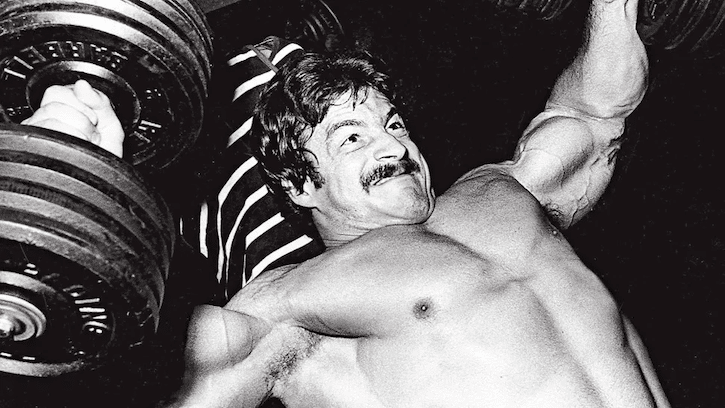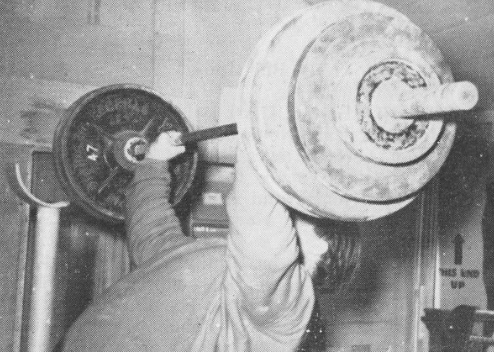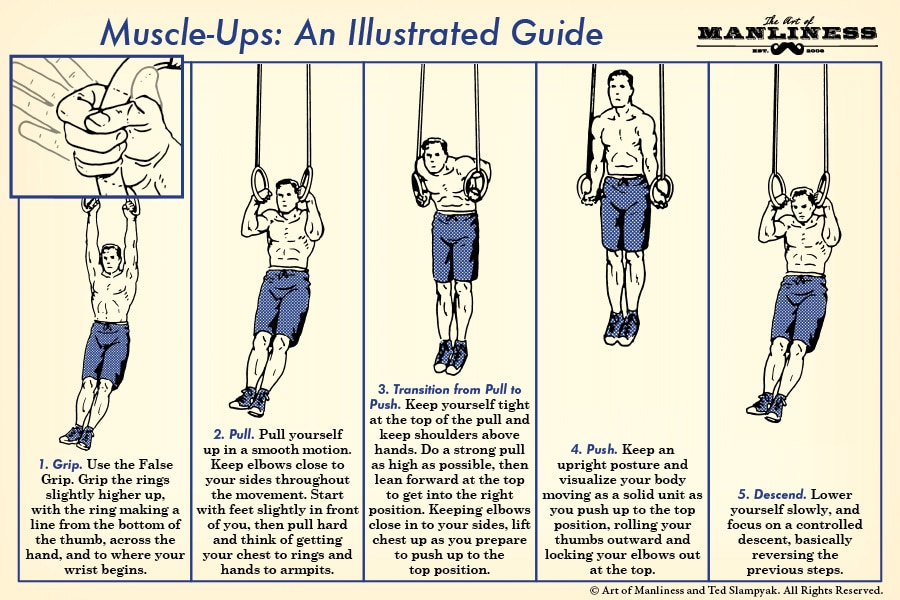
For the past several months, the Instagram algorithm has been blitzing me with content about legendary bodybuilder Mike Mentzer.
Maybe it’s because the algorithm has picked up on the fact that I’ve transitioned away from powerlifting and am doing more bodybuilding-type workouts these days. Or perhaps the algorithm thinks I might appreciate Mentzer’s awesome mustache since its majesty rivals my own.
Whatever the reason, thanks to Instagram, I’ve been learning a lot about Mike Mentzer and his iconoclastic training philosophy that he called “Heavy Duty.”
The young bros on social media are absolutely bonkers about Heavy Duty. And I can understand why.
First, there’s the appeal of Mike Mentzer himself. He had an amazing physique (he was the first and only man to earn a perfect score in the Mr. Universe competition), and his 1970s hair and stache gave him lots of cool cache. On top of that, he brought a rare philosophical bent to bodybuilding. His tear-drop spectacles evinced his bookish personality, and he loved studying and discussing different schools of thought (particularly Ayn Rand’s Objectivism), looking at art, and listening to good music. For a lot of guys, this combination of brains and brawn really represents the ideal of manhood.
But Mentzer’s Heavy Duty program is getting a lot of hype these days on social media because it promises exceptional muscle growth by potentially only doing a single set of exercises per body part per week.
Mentzer’s idea that you could get hypertrophic growth with infrequent and short workouts flew in the face of the bodybuilding orthodoxy of the 1970s and 80s. During that time, high volume was king. Bodybuilders back then, like Arnold Schwarzenegger, trained for two hours, twice a day, every day. The goal was to slam your muscles with double-digit sets to stimulate growth.
Influenced by Nautilus inventor Arthur Jones’ philosophy of high-intensity training, Mentzer thought doing so much training was a waste of time and led to suboptimal results.
Intrigued by the hoopla and claims of Heavy Duty, I decided to take a deep dive into the program and its claims. Here’s what I found out about how it works, and whether it works.
The Principles of Heavy Duty
The first thing to point out is that Heavy Duty isn’t a wholly unique training philosophy. It’s a variation of high-intensity training in which athletes are prescribed to train their muscles to failure. As mentioned above, Arthur Jones pioneered high-intensity training. Mentzer probably did the most to popularize high-intensity training thanks to his work with Dorian Yates.
Mentzer’s Heavy Duty philosophy evolved over the years. Most bodybuilders (and many sports scientists) think Mentzer’s early version of Heavy Duty got a lot of things right. However, Mentzer became more extreme with his views as he got closer to his death, particularly regarding volume and frequency.
It should be pointed out that Mentzer had genetics that made him well-suited to bodybuilding, and he achieved his physique partly through the use of anabolic steroids. But he thought his recommended lifting regimens equally applied to average, drug-free individuals who wished to achieve their natural muscular potential.
High Intensity
Intensity is the key to Heavy Duty. For Mentzer, the intensity of the exercise is what drove muscle hypertrophy, not volume. So, what did Mentzer mean by intensity?
He defined it as “the percentage of possible momentary muscular effort being exerted.”
Mentzer (and other high-intensity training proponents) believed you needed to get reps as close to 100% exertion as possible to stimulate muscle growth. And you only know if you’re getting to 100% exertion by lifting until failure.
Mentzer on intensity:
That last rep where you’re trying as hard as you can, and you barely make it! That is what turns on the growth mechanism in your body. That last almost impossible rep where you’re bearing your teeth, you’re shaking all over, you need assistance! That rep is very special, that rep is very different. There’s something special going on inside your body when that happens.
Scientific research has verified this claim. In my interview with bodybuilding coach Paul Carter, he explained the concept of “mechanical tension” as what stimulates muscle growth. As you get closer to failure with a lift, your muscle fibers start experiencing more mechanical tension. You know when you’re achieving mechanical tension if the movement of the lift starts slowing down and feeling hard. Those reps are the “stimulating reps.” They’re the ones that begin a cascade of signals in your body to start growing more muscle tissue.
To ensure you achieve adequate intensity, the movements on your lifts need to be controlled. Lift and lower the weight smoothly and slowly, without jerks or sudden movements. You don’t want to add any momentum to the lift, making it easier. A common cadence of high-intensity practitioners is 2-2-4. Two seconds on the concentric part of the lift, a two-second pause, and four seconds on the eccentric part of the lift.
To increase intensity, Mentzer advocated things like “pre-exhausting” a muscle group, using assisted lifting (where you have someone help you with the final reps), and holding the weight steady at different points in the lift. All of these methods were designed to help a bodybuilder get closer to failure faster.
The big takeaway from this principle is that to stimulate muscle growth, you must do each exercise until failure. It’s got to be Heavy Duty, baby.
Low Duration (or Low Volume)
The big draw of the Heavy Duty method is the low volume you do.
While you can achieve mechanical tension with a high or a low number of reps, it’s easier to achieve the intensity necessary for mechanical tension with the latter.
If you’re using lighter weight, you’ll have to do more reps before your muscles start getting into mechanical tension. As a result, you’ll experience more fatigue, making it harder to keep up the muscle-building intensity of your lifts.
If you’re using heavier weight, you can do fewer reps while jumping into the intensity needed to create mechanical tension sooner.
Think of it like this: if you’re doing bicep curls with 10-pound dumbbells, it could take you 50 reps to achieve the intensity needed for muscle-building mechanical tension, and you might get fatigued before you even reach that point. If you’re curling 50-pound dumbbells, you might achieve mechanical tension in just 3 reps, saving you fatigue and time.
Mentzer figured you could use that saved time for studying philosophy or art.
As mentioned above, Mentzer’s philosophy towards volume evolved as the years passed. When he first presented Heavy Duty, he prescribed 1 to 2 sets of 6 to 8 reps for each exercise, done to failure. If you could get to 12 reps in a set, you needed to increase the weight by 10%, drop your reps back down to 6, and start working your way back up with the reps at that new weight.
So what does that look like?
Let’s say you’re training your quads; a Mentzer-style Heavy Duty program might look like this:
- Leg extensions: 2 sets, done to failure
- Squats: 1 set, done to failure
- Leg press: 1 set, done to failure
That’s 4 total sets for the quads.
A high-volume workout might have you doing 4 sets of each exercise, giving you 12 total sets for your quads.
4 sets compared to 12 sets. You can see why Heavy Duty is considered a low-volume program.
In the 1990s, Mentzer developed Heavy Duty II, which proposed workouts where you only did a single set for an entire muscle group. One suggested program looked like this:
Workout 1
- Squats: 1 set, done to failure
- Close-grip, palms-up pulldowns: 1 set, done to failure
- Dips: 1 set, done to failure
Workout 2
- Deadlift: 1 set, done to failure
- Presses behind neck: 1 set, done to failure
- Standing calf raises: 1 set, done to failure
That’s it.
As mentioned above, most bodybuilders think Mentzer got things right in his earlier version of Heavy Duty. The scientific research seems to confirm Mentzer’s original volume recommendations.
According to Paul Carter, research suggests that, in general, beyond doing 8 sets to failure per week per muscle group, there’s little to no benefit to adding volume. If you’re doing more than that, you’re just needlessly fatiguing yourself. While one set to failure per week will provide stimulus for muscle growth, it’s likely not enough for maximum hypertrophy. According to Paul, the research suggests that 3 sets a week per muscle group seems to be the floor for hypertrophic gains.
However, some bodybuilders and some research suggests that you get more hypertrophic growth with more volume. Like in the 12-20 sets per muscle group per week range.
Which one is it? It’s been a topic of debate for a long time.
Bros were debating volume on the bodybuilding.com forums 20 years ago. They’re still yelling at each other about it on TikTok stitches today. They’ll probably have flame wars about volume on some 3D virtual reality platform 20 years from now.
As long as you lift to failure, doing either high or low volume is going to work fine for growing muscle for the average dude, so go with whichever methodology you prefer. The big advantage of going the low volume route is that you can get swole in less time.
Low Frequency
Recovery was an essential part of Mentzer’s Heavy Duty philosophy because recovery is when our muscles grow from the stimulus of weight lifting. To maximize recovery, Mentzer advocated for significantly spacing out one’s workouts. In the most extreme version of Heavy Duty, he prescribed doing 1 to 2 sets for a muscle group just once a week. The other six days would be used for recovery.
The research is mixed on whether low frequency helps or hurts hypertrophy. One meta-analysis showed that as long as you get in enough done-to-failure sets for a given muscle group during a week, it doesn’t matter if you train once or twice a week.
So, let’s say you aim to do 6 sets per week for your chest, again making 6-8 reps per set the ideal range, sometimes going up to as many as 12 as you get stronger, before increasing the weight by 10% and going back down to 6 reps per set.
You could have a chest day where you get all 6 sets for the week in that single workout.
It could look like this:
- Fly deck: 2 sets, done to failure
- Incline bench press: 2 sets, done to failure
- Cable crossover: 2 sets, done to failure
You’d then do your chest day again a week later.
You could also split up those 6 sets over 2 workouts, like so:
Workout 1
- Flydeck: 2 sets, done to failure
- Incline bench: 1 set, done to failure
Workout 2
- Cable crossover: 2 sets, done to failure
- Bench press: 1 set, done to failure
According to the meta-analysis referenced above, either breakdown would be fine.
But another recent study suggests that training a muscle group more than once a week has more benefits than just training it once a week, even if the total sets are the same.
I couldn’t find any strong agreement on frequency amongst bodybuilders. It often came down to personal preference. As long as you’re getting your volume between 3 to 8 sets a week for a given muscle group, how frequently you train depends on what you want to do.
Progressive Overload
For Mentzer, progressive overload is how you know if the program is working. If you can add reps to a set before you hit failure or add weight each workout, the adaptations in your muscles that will help drive hypertrophy are occurring.
One thing Mentzer pointed out is that when it comes to muscle growth, strength comes first. You’ll notice yourself getting stronger before you notice yourself getting bigger. That’s because we acquire neural adaptations that allow us to lift heavier faster than we create muscle tissue. Expect it to take several months before you start seeing noticeable increases in muscle size.
How I’m Using Heavy Duty Principles in My Training
I’ve incorporated some of the big principles from Mentzer’s Heavy Duty philosophy into my training. I’m training to failure using a weight that allows me to complete around 8 reps before failure. That’s been the most significant Mentzer influence on my training.
In terms of volume, I aim to get 6 to 8 sets per muscle group per week. It’s not the super low volume of Mentzer’s Heavy Duty II, but more in line with his original Heavy Duty method.
Regarding frequency, I do an upper/lower split where I train my upper body on Monday and Thursday and my lower body on Tuesday and Friday. So I break up my sets for each muscle group across two workouts a week.
And each workout, I try to add reps or weight so I’m getting the progressive overload in.
It’s been fun learning more about hypertrophy and muscle growth. While I don’t think Mentzer got everything right, he’s served as a gateway for me into the interesting world of high-intensity training. I’ve really been enjoying it and am looking forward to experimenting and learning more.
To learn more about hypertrophy and how to grow your muscles, listen to our podcast with Paul Carter:







